
|
|
|
Search our site
Check these out    Do you have an entertaining or useful blog or personal website? If you'd like to see it listed here, send the URL to leon@pawneerock.org. AnnouncementsGive us your Pawnee Rock news, and we'll spread the word. |
Too Long in the WindWarning: The following contains opinions and ideas. Some memories may be accurate. -- Leon Unruh. Send comments to Leon January 2007Biking Across Kansas[January 31] The annual Biking Across Kansas tour route has been set, and it comes near Pawnee Rock. The 496-mile route begins June 9 at the Colorado state line west of Tribune, where K-96 disappears into the horizon. Cyclists will spend the night in Tribune, Leoti, Ness City, Hoisington, Lincoln, Clay Center, Centralia and Troy before dipping their tires June 16 in the Missouri River at Elwood. Elwood? I had to look it up too. Elwood is in a little notch of land just west of St. Joseph, Missouri. It's where the Pony Express entered Kansas, and it's the first place Abe Lincoln set foot in Kansas when he was campaigning for president. I've made the BAK ride twice, but back in 1984 (middle of the state, including through Larned) and 1985 (southern counties). I signed up on Kansas Day for this year's ride. Maybe I'll see you there. I'll be the guy without a tan. Biking Across Kansas Friends: We have a new Friend of Pawnee Rock: Sandra (Cooper) Harris of Hutchinson. Her Cooper grandparents used to own Pawnee Rock's drugstore, and her dad was the school custodian until 1960. Friends of Pawnee Rock Lots of energy: Peg Britton, our Ellsworth connection, is not going to accept wind turbines that spoil the view of the Smoky Hills or that present other problems. Her Kansas Prairie blog bubbles over with well-reasoned opinions, and she's a fun writer, too. If I were a utility company, I don't think I'd want to get on the wrong side of Peg. www.kansasprairie.net Tim Vandenack of the Hutch News updated the story about the need -- or not -- for two of the three coal-burning power plants that utilities want to build in Holcomb. Power plant timing questioned | My thoughts on December 15 The Damsels of Pythias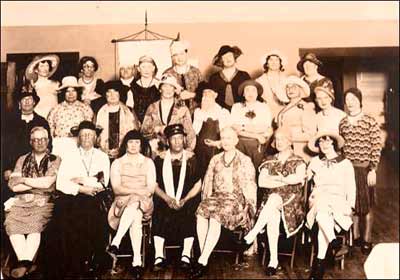
[January 30] Let's say it's the 1920s and you're a businessman living in Pawnee Rock. You're also a member of the lodge, the Knights of Pythias, which meets in the opera house where the main street intersects the highway. Having read a suggestion in a book about how to add pep and vigor to lodge meetings, someone suggests that you all show up one night in your wife's or mother's dress. Frivolity ensues. But a month later, you do it. 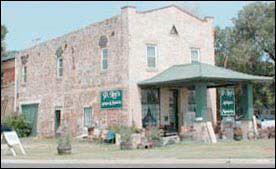 You have a sense of humor, and so do your pals from the elevator and stores and the automobile garage, and you're really glad your wife does too. You sense that it doesn't make her really happy that you're wearing her makeup, her scarf, and her dress -- and that it's roomy enough to fit you. But it's really OK to do this. After all, people have been dressing up for shows at the opera house since it was built in the 1870s. That's what people do for entertainment. That might change, though, now that those new talking movies have started to show up in Great Bend. You and two dozen of your girlfriends pose for a photo; most of you on the front row remember to cross your legs genteelly. You wouldn't imagine that the photo would still be around 75 or so years later, but it is and your great-grandchildren are glad it is. Who knows, maybe some of those descendants will remember the days when their own dads were tail-twisters at the Lions Club and had their own pushy-rowdy-bawdy fun. We great-grandchildren -- more directly, I -- tend think of the black-and-white days as generally humorless years of struggle leading down to the Great Depression. But photos like the one of the Knights reveal that at least 25 of them did have a funny bone and for (at least) one night they enjoyed seeing themselves as wives, girlfriends, daughters, or mothers. Nowadays it's easy to stay home separately to watch cable television or read something on the Internet. It's a shame that we've lost some of the unity and glee that once allowed a bunch of farm-town guys to expose their alter egos -- and to do it in front of guys they would do business with the next day. I don't know whether I'd be able to dress up like that; my wife's clothes are too small anyway. But I do think the lady in the front row, third from the left, is kind of cute in a French way. We salute the Kansas flag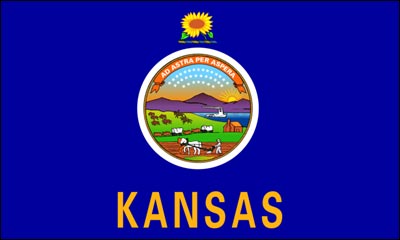
[January 29] In honor of Kansas Day -- this is the 146th anniversary of our joining the Union in 1861 -- I thought we'd go back to sixth grade and review what we know about the Kansas flag. Flag adopted: The legislature gave its approval to the flag in 1927, or 80 years ago. The flag was first flown at Fort Riley for the soldiers and the Kansas National Guard. Ben Paulin was the governor. Blue field: Why is the flag blue? Well, you know which side Kansas joined during the Civil War. It's also possible the blue is for our sky and for our dream of plentiful clean water. State seal: The sun rises behind mountains or the Flint Hills to the east; the Kansas River is for shipping goods by riverboat west from Kansas City to the early populated lands around Lawrence, Topeka and Manhattan; the wagon train (Manifest Destiny) heads west; bison are grazing their way to near extinction; a farmer plows near his cabin (agriculture); 34 stars stand for the 34th state; and the motto is "Ad astra per aspera," which all schoolkids have joked about and means "To the stars through difficulties." Sunflower and bar: The blue-and-yellow bar has to do with the Louisiana Purchase, which our land was part of. The sunflower supposedly symbolizes Kansans' boldness but may simply be the only flower that would grow in droughty Kansas, and it goes well with blue. Kansas' flag drips with symbolism. It is so Kansas-y, trying to wrap up the history of the state and imitating (on a smaller scale) those Renaissance paintings that art historians are always dissecting, the kind in which every element means something. My guess is that the flag was drawn up at the behest of boosters who wanted to reassure the big-money folks back east that Kansas was a safe, normal place to invest their funds despite what they might have read about populists and Goat-Glands Brinkley. Kansas' flag can be painted by the numbers. Here's a snippet from the legislation that covers the flag: "The colors in the seal shall be as follows: Stars, silver; hills, purple; sun, deep yellow; glory, light yellow; sky, yellow and orange from hills half way to motto, upper half, azure; grass, green; river, light blue; boat, white; house, dark brown; ground, brown; wagons, white; near horse, white; off horse, bay; buffalo, dark, almost black; motto, white; scroll, light brown." Designing a flag may seem like a simple act. Look at the flags of Texas or Alaska, Colorado, New Mexico, or especially Alabama. Those states clarified their thinking and came up with clean designs. If they used a committee, it's not apparent. If Kansas were to shuck its 1860s-based flag, what image could we use instead? • A shock of wheat Happy Kansas Day Birthday to Julie Wright, my boss at the newspaper and a fellow transplanted Kansan. You may know her name from the many years she wrote for the Wichita Eagle. Inspiration is where you find it[January 28] Our Sunday school class had been assigned the task of flipping through old magazines and finding advertisements and large type that could be turned into posters. It was practical work for a bunch of sixth-graders in the basement of the Bergthal Mennonite Church. As I remember it, I tried out a couple of weak ideas from the Better Homes & Gardens magazine. Then inspiration came with the flip of my wrist. There was a full-page ad for a brand of margarine with a play on "spread" in its name. The woman in the ad wore an exaggerated expression that matched the slogan: "Spred the word? Who, me?" I glued the ad to a piece of typing paper, and the teacher taped it to the wall at the top of the stairs. It was a clever poster, I suppose, but I really had done nothing more than use someone else's work for a different purpose. When the Rev. Gerhard Peters began his sermon by mentioning my poster, I was stunned. What had he seen that I hadn't? "Spread the word," he intoned. That's the purpose of the church, he said. "Who, me?" he asked. "Who else?" he said. That small incident has stuck with me all these years because of its accidental nature. Unless I showed subconscious genius, I was just fulfilling an assignment with a catchy ad. But someone else, who was looking for inspiration, saw it differently. A few days ago, my friend and coworker Lillie Dremeaux was discussing a popular singer named Fergie, who Lillie thinks is famous not so much because of her own talent but because of the quality of the songs others write for her. "She's just a vehicle for other people's good ideas," Lillie said. Whether that's true about Fergie, I couldn't say. But I was struck by the all-purpose insight of Lillie's remark. Once in a while, being a vehicle is the best I can hope for. Maybe it's that way for others, too. So spread that word, whichever one's important to you. Someone waits to be inspired. Kay (Peters) Steed, who has long roots in Pawnee Rock, has joined us in the Friends of Pawnee Rock section. Welcome, Kay. A photo I like: No. 21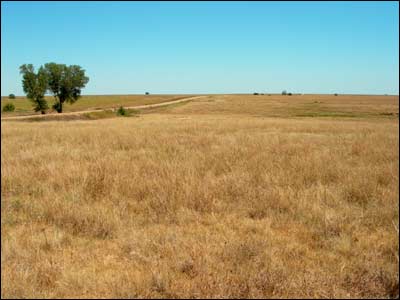
[January 27] The pasture was my playground when I was a kid -- unless Uncle Laramie's cattle were here first. This particular spot is between my Unruh grandparents' farmhouse and the one owned by the Elrick Smith family. The land is now owned by Durward Smith, who let me stroll across it last summer. Doing that brought back memories of hunting rabbits, of exploring in all four seasons, and of devil's claws. The image is how I remember the country: thick and usually brown grass, a sky so blue you could fall into it, cottonwoods living in the draw where the dirt was the dampest, and the east-west road just waiting for a driver to raise a dust plume. Climate control and you[January 26] The Wichita Eagle ran a story Tuesday about how Kansas is doing its best to fight rising energy consumption. It shows Kansas ranking 13th in energy usage per person. 1. Alaska 1,175 million Btu per year Drive less, the Eagle story quotes Liz Brosius of the Kansas Energy Council as suggesting. That's a good idea anyway most of the time. Drive a little slower, too. Gov. Kathleen Sebelius, meanwhile, wants Kansans to generate more electricity with wind turbines. But really, what can Kansans do about household usage? There sits the Sunflower State, caught between the Canadian steppes and the Gulf of Mexico. With furnaces and humidifiers running in the winter and air conditioners in the summer, it's a surprise Kansas ranks only 13th. You and I, however, know a lot of Pawnee Rockers who don't rely on mechanically altered air, folks who sit on the porch in the summer evening and wear a sweater in the fall. People who sleep under an extra blanket in the winter and in the summer enjoy the sound of rattling leaves and distant thunder outside the screened window. Now think about Texas, and imagine the savings possible there. If everyone in Texas raised their air conditioner thermostat 2 degrees, half our county's energy problem could be solved by July. Texans, I know from having been one -- and Louisianans, according to the Eagle's list -- do their best to hide from the humid climate. Their houses are air conditioned, and as soon as they start their cars the AC goes on there, too. Their offices, stores, and restaurants are c-o-l-d; they want eternal early springtime. Texans' relationship with nature is based on showing their blunt dominance over the climate. I'm not criticizing; I write that because I love Texans. The thing I've found that helps me enjoy the weather in any season is to just get out in it. There's nothing wrong with shivering a little or even sweating, when that's called for. Demanding that the air around me be artificially managed every hour of every day is a fool's game. I know what I'm talking about. I've played the fool. Kansas in Alaska: The list that had Kansas in 13th place for per capita usage showed Alaska at No. 1, which should be no surprise. It must be pointed out, however, that there are fewer than 700,000 of us, so all in all Alaskans don't take up a whole lot of energy.We Unruhs are doing our part for the conservation of natural gas and money. This winter our thermostat is set at 65, and that's fine. (We don't have an air conditioner.) Sometimes our climate throws a surprise at us. Last night my wife and I celebrated because we had some Kansas-strength winds. They came up about 9:30 p.m., instantly whipping a blizzard off Wal-Mart's rooftop acreage as I drove past it on the way home from work. By midnight, the warm air off the gulf pushed the mercury over 32 degrees for the first time in a month. There are drifts today. Yee-hah! Here's Kansas in Alaska, according to Weather Underground: Thursday night: Cloudy. Blowing snow along the Upper Hillside will reduce visibilities to near zero at times. Lows in the teens. North wind 15 mph in town increasing to southeast 35 to 45 mph after midnight. Along Turnagain Arm and higher elevations ... southeast wind 50 to 70 mph with gusts to 85 mph. Friday: Mostly cloudy. Isolated rain and snow showers. Highs in the 30s. Southeast wind 15 to 30 mph. Along Turnagain Arm and higher elevations ... southeast wind 35 to 50 mph with gusts to 75 mph in the morning. Southeast wind decreasing to 20 to 30 mph in the afternoon. It felt good last night to stand outside under the waving trees, my back to the wind, and be lofted away by the lullaby I heard as a child. Mail call and lots of corn[January 25] This just in from the PawneeRock.org mailbox: From Arizona: Jared Smith wrote that even in his desert city, Mesa, civilization doesn't stop when a decent snow falls, as one did a few days ago. Jared wrote: "Unfortunately we didn't get a 'snow day' out of that! One of the reasons I moved to AZ was to avoid that kind of weather. In 18 years of delivering the mail in AZ, never have I once worn long pants at work! As for the city shutting down, that didn't happen, but the snow did bring out unusual behavior in people around here. Only in AZ would you see someone driving around with a snowman on the hood of their car!" From Indiana: Ray Randolph of Indianapolis grew up near Bushton and in Hoisington before going on to school in Winfield and Indiana. He admits to having been on the Rock a couple of times. "I have always wondered what might have been if I had gone back to Kansas," he wrote. "... Nowadays my head may be in Indiana, but my heart is more and more in Kansas." Discussing our January 20 photo of the abandoned farmhouse, he wrote: "I also wonder of the many stories that will never be told about their inhabitants and their reason for being empty." 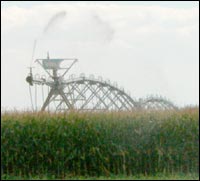 It's green for somebody: As you know, during his State of the Union speech on Tuesday President Bush called for more use of alternative fuels -- including his favorite, ethanol. An interesting statistic offered by an opponent was that to make it possible to get enough ethanol to cut gasoline use by 10 percent on Bush's timetable, we'd have to plant all of Kansas and Iowa in corn. Or switchgrass, or whatever green fuel becomes popular. It made me wonder: There's hardly enough water now to irrigate the crop circles that provide the world with corn syrup and high-fructose corn syrup and overpriced masa for tortillas. Out of whose aquifer would an Exxon/ADM ethanol conglomerate water its factory-farm, low-employment crops? How quickly could those "national security" companies buy up the legislature to get the rest of western Kansas' water? If we're going to mess with water anyway, maybe our country ought to develop a workable hydrogen-cell auto engine and burn it there. Big gallery: Just a reminder to stop by the new big-images gallery and read the PRHS Chieftain newspaper. If you have anything like that -- another Chieftain, or something similar -- I'll be glad to post it there, too. The more we share, the more we all get smarter. Feel good about Kansas[January 24] Kansas Day is just around the corner. Get in the mood with Pawnee Rock expatriate Cheryl Unruh, the master of all media. Our favorite Emporia blogger has a Kansas Day report on Kansas Public Radio and a great Emporia Gazette column about something we strive for every day: the horizon. The winter wonderland[January 24] When I was a boy in Pawnee Rock, I tried to count the stars. I have tried to figure out how many leaves are on a tree, and how many trees are in a forest. And how many stones are in the Arkansas River bed. I always want a number. Last night as I drove home from work through what must be the 20th snowfall of the season, I noticed illuminated cones expanding under the 70-foot-tall lights around the interchanges. I wondered, Do 10,000 new flakes pass through those cones every minute? I passed shorter cones of snowflakes all the way home. Two thousand more flakes, perhaps, for every streetlight. Falling minute after minute for hours, covering the highway with a billion flakes an hour. Far beyond our little storms, the Big Dipper's closest star (the third one from the end of the handle) is 68 light-years from you and me. That's 399 trillion miles, or one mile for every snowflake this winter here in coastal Alaska or there in western Kansas. Some numbers can be pinned down exactly: I now live 2,658.3 miles from Pawnee Rock. Still, there are days when I look at the world around me and it feels like I'm a million miles from home. I know I can't count all the stars or snowflakes, any more than I can count all the stones in the riverbed. Instead, I must -- I get to -- wonder. I think I'm just as happy that way. From the PRHS Chieftain[January 23] The date was May 12, 1972. Pawnee Rock High School had just been through track season and the junior-senior prom, and the honor roll had been announced. There was news in the last edition of the Chieftain, Pawnee Rock High School's student newspaper. I found my copy of the Chieftain recently, and it was a treasure to behold. I had forgotten what lives we had back then. Not all of it was pleasant, especially for us freshman, but we were busy. Here are some tidbits: • Semester exams were scheduled for May 24 and 25. • Fifty-three percent of the student body had perfect attendance in the fifth six-week period. Oddly enough, seniors had the lowest perfect-attendance rate, 37 percent. • Rick Stegman's birthday was May 5. • The plans of 14 seniors were announced. Jeanine Mull planned to go to Kansas State University to major in home economics. Jyl Behrens was on her way to a career in fashion design. Verlin Morgan was going to work. Arlan Nokes had plans to be a truck driver. Brenda Smith aimed at becoming a nurse or teacher. • Fifth-grader Sonja Wilson produced a haiku: The River • At the league music festival in Lewis, I's were awarded to junior high students Karla Mead, drum; Kim Myers, flute; and Marilyn Stimatze, Debbie Miller, Randy Clawson, and Paul Haislip, vocal solos. Big pictures: I have created a new gallery to display images that need a little more space than they'd get in our regular gallery. Images with printing -- the Chieftain, for example -- will be easier to read. In fact, I've loaded the Chieftain for your amusement. See whether you remember any of the dozens of people mentioned in its pages. Here you go: Big Pictures from PR. Because these images are bigger (about 150k instead of the usual size of about 45k), it will take a little longer to load them. They're worth the wait. Lurking below the surface[January 22] Our Boy Scout troop sometimes spent the weekend at Lake Wilson. Our scoutmaster then was Ron Stark, a former Navy construction engineer who liked the water so much I wonder why he chose to move back to central Kansas. On one trip, we put our troop's Navy surplus 12-man raft on the water so we could go fishing. We figured we'd drift a little way out and then row back. The south wind had other ideas, and within an hour we were blown hard against the north shore. For gas money, a couple of fellows in a motorboat towed us back to camp. What made this trip to Lake Wilson special -- at least for one scout -- was Ron's scuba gear. Ron went down for 10 minutes and then invited us all to lower ourselves into the lake wearing the tank, mask, weights, and flippers. I didn't think I was a good enough swimmer. Others might have been a little leery of new adventures after our trip across the lake the day before. Only Ray Tutak took the dive. He reported seeing a giant catfish, a creature we all suspected lived in the depths. The fish got bigger every time we heard the story told, but who among us could prove him wrong? The rest of us scouts probably were justified in not trying out the scuba gear. None of us was trained in diving, and none of us was an especially strong swimmer. But -- and this is the part that haunts me -- think of how much larger our worlds would have been had we gone beneath the surface. The next time the tanks are offered, I'm going to accept. Shoveling for fun[January 21] I shoveled lots of wet snow in my day in Pawnee Rock. You might still find scrapes in the uneven sidewalk in front of 412 Santa Fe where our metal shovel worked its way through the snow and ice. I wasn't an expert then. I bent a few shovels, working the lower corners up like dog ears as I attacked ice in frustration. I also didn't pay much attention to the cardinal rules of snow shovelry: Keep your shovel cold, shovel before the snow gets slushy, and keep your gloves dry. Snow clots up on a warm shovel, so don't store the shovel inside. Dry snow is a lot easier to control than slush and more rewarding to shovel (although a shovelful of slush does make an entertaining gloppy splash.) Wet gloves make your fingers miserable, and the moisture can freeze up where you hold the shovel. These are things I've learned during my years in snow country. It isn't book learning. One more thing: Don't fill the shovel too heavily. I don't want to hear of any PawneeRock.org readers ending up in the hospital. No heart attacks! Now, if someone will send a photo of the snow in Pawnee Rock, I'd be glad to post it on the home page. Here's a favorite snowtime game: Count the number of times the newspaper or TV/radio announcer strains to find a synonym for snow: flaky white stuff, white blanket, and so on. The game's winner is the one who first hears "but it's good for the wheat." A photo I like: No. 20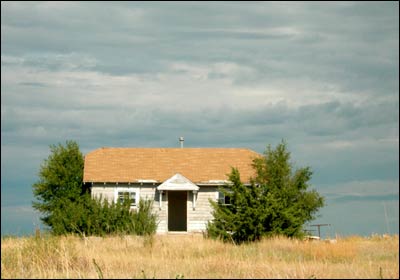
[January 20] This house sits on a rise north of Pawnee Rock. I photographed the place late on an August afternoon as the sun hit it almost head-on. The house seems to be receding into the land, swallowed up by gone-wild grass and the cedars that have for decades protected it from the wind. Depending on how you look at it, the photo is evidence of both a classically romantic descent into decay and a statement on the difficulty of farm life. Or it's just a house people don't live in anymore. Art Buchwald, my friend[January 19] Those of us who grew up reading the Hutchinson News were given Art Buchwald two or three times a week. His column, which poked fun at society in general and overbearing politicians in particular, appeared on the editorial page. My parents didn't point him out to get me started reading him. It may have been the mugshot of his round face with the glasses and cigar that drew me in. Here's a guy, I sensed, who wasn't a stuffed shirt. His columns were carried by 400 papers back in the 1960s and '70s, which was when his writing was the most pointed. He wrote thrifty paragraphs with a lot of dialog, and the columns were sprinkled with words that hormone-driven teenage boys would pick up on: blonde, Vietnam, scandal, Watergate, Stork Club. Buchwald and Jack Anderson and Erma Bombeck ruled the syndicated-column crowd, for my money. Now you know who made me the writer I am today; that is, I struggle to be as insightful as they were. Buchwald's columns were collected in paperback books, and I was enchanted by them in high school (I still have the books). They were history with an attitude. Most important for me, I think, was that they revealed how the political world could be entertaining. Buchwald worked hard on his writing, and when he was at his peak every column was good from top to bottom. His syndicate sold his column worldwide, and he tracked his column with pride. When I worked in Austin, our newspaper carried Buchwald's column but usually trimmed a few paragraphs to make it fit the space allowed for it. One day an editor at a convention told Buchwald that he read the column in the American-Statesman. "No, you haven't," Buchwald grumbled. Buchwald died this week in Washington, D.C. He was 81, and he left this world with grace a year after being told he had only a few weeks left. Credit where it's due: I forgot to give Larry Smith credit for providing that superb photo of John Lindas, which appeared on the homepage yesterday and took up residence in the Gallery today. As you all know, Larry sends us many great photos of old Pawnee Rock. Life with a point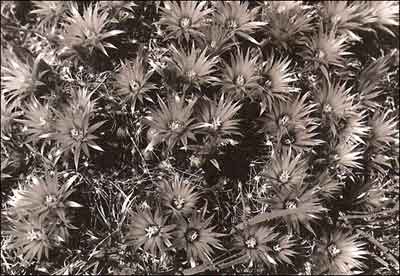 [January 18] When you spend much time at the Pawnee Rock cemetery, the nearly invisible, low-growing cactus plants become a pretty important part of your landscape. You might sit on one once, or kneel too close, but afterward you'll see every cactus that's alive and ghosts of the ones that are long gone. Cactuses are a part of a complex grassland ecosystem. In fact, when the weather warms up a little, I'd recommend heading out to the cemetery. Stroll among the stones and see how many kinds of plants you can find under the cedars. Many plants -- from peonies down to the little clovers between strands of the buffalo grass -- are gentle and susceptible to any foraging rodent that wanders by. Cactuses, however, intend to live forever. They're succulent and pretty, but don't push them around. Frozen in time[January 17] Our house in Pawnee Rock used to have a thermometer nailed to the bark of the big elm tree just outside the kitchen door. One winter we watched the mercury drop, then drop some more. It bottomed out at minus 10. I was excited -- 10 below! -- and a little intimidated by the sharpness of the air. The whole world felt brittle, and even our house seemed unsure of itself. The furnace was always on. Dad and Mom talked about the pipes. Frost grew thickly on the inside of our windows, and cold air poured down off the panes onto my bed. Those were the days when Grandma Unruh would have her farmhouse sealed off against the weather, using only the kitchen and the living room, where she slept on a cot. She walked to the outhouse rather than use the indoor plumbling, which was connected to the septic tanks by pipes in the inadequately insulated crawlspace -- and the water was always left running. I remember those days fondly, having now stepped out of Kansas' knife wind. On the two or three nights a year when Pawnee Rock's temperature is lower than ours here in Eagle River, I am happy for Kansans. Kansas is where people are forged by the climate. When I lived there, I used to boast that there's nothing between the North Pole and Pawnee Rock but a few fenceposts in the Dakotas. We all have our degrees of "cold." For example, who among us would want to spend January in North Dakota? On the other hand, the briskness that Kansans endure routinely is a little tough on folks to the south. Susan Unruh Ellis, now in Louisiana, wrote Tuesday evening to describe how her town is dealing with the cold wave: "They are closing the public schools in Lafayette tomorrow due to cold weather. It froze last night and will again tonight. The wind chill is in the teens for the next several days. "Seriously, they have heating capacity for the schools to hold them at 55 degrees. When they reach the point of not being able to keep the classrooms comfortable, they close the buildings. We have air conditioners, not large furnaces down here." Cold weather is a purifying force. The air is never cleaner, the sky never clearer than after a cold front passes. And winter, like everything else, will pass soon enough. Without the cold, we don't appreciate spring. Without sodden days, we don't appreciate sunshine. Without evenings at 105 degrees, we don't appreciate autumn. And without the decay of autumn, we don't appreciate reaching the bottom of the year and starting fresh. The magic show[January 16] There is a little magic in everyone's life. Sometimes it's a kiss, sometimes a happy coincidence. 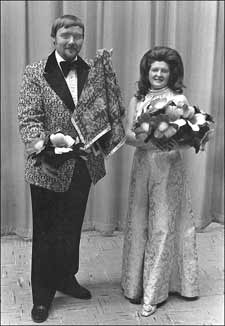 In 1974, it was Rex and Shari. The Pawnee Rock Lions Club hired Rex, a magician, and Shari, his wife and assistant, to provide the entertainment at a fundraiser. They were from someplace exotic: Ness City, perhaps. As the unofficial photographer for the Lions Club and the Tiller & Toiler, I got to meet Rex and Shari in the Saturday afternoon before the show. We chatted on the stage in the school gym, where they would later perform. I expected characters as mysterious and moody as Mandrake, but Rex was jovial and helpful. Part of their showmanship was that they wouldn't allow pictures to be made during the show, and they wouldn't perform any tricks while I had the camera to my eye. But they cheerfully posed for 10 minutes of their rehearsal time and then let it be known that I was to leave. Rex's jacket still looks like upholstery from an overwrought couch, and Shari had the biggest hair I have ever seen. That probably was part of the show, too -- making themselves larger than life. That evening, Pawnee Rockers packed a dozen rows of folding metal chairs set up across the gym floor. I don't remember many details about the show, but we laughed and gaped in amazement. I heard some of the people in the seats say "I know how he did that!" but no one ever copied the tricks. Maybe it really was magic. Susan's memory[January 15] I got a wonderful long note last week from Susan Unruh Ellis. I'm sure you remember Susan. She's the sister of George Unruh and the daughter of Dean and Nancy Unruh, and she grew up in the house with the big porch west of Milton and Merita Rice's place.  Susan's e-mail had tales of the Svatos family, of the day the gypsies robbed the safe at the grocery store when it was owned by Dee Jost, of neighbor Bud French's determination to keep driving, of seeing the hunter's trophies in Rolla Fry's house, of the old buildings downtown being torn down and the mortar chipped off the bricks, of the north door (with the Rainbo Bread push bar) on the grocery store when it was Hixon's, and of Betty German's kindness when she was a clerk at the store (ringing up nickel packages of Kool-Aid separately so kids wouldn't have to pay tax on them). What a mind for memories! Susan and her husband, Don Ellis from Rozel, live in Lafayette, Louisiana, where she has been an accountant and he works in the oilfield and consults. They have a couple of grown kids. Thanks: Gary Trotnic and Cheryl Unruh both sent me copies of the Tribune stories about Treasa Carter's death. I appreciate everyone's efforts in making sure our hometown news reaches the widest audience. In memoriam: Richard Adair of Pawnee Rock, a retired railroad engineer, died January 6 in Wichita. His wife is Gaila. A memorial service will be held later. Obituary (January 14) The perfect instruction: Last night, the swimming instructor was coaching our son Nik on his backstroke and praised him for an improved effort. "I didn't ask for 'perfect,'" Richard said. "I just asked for a little change." Wow, I thought to myself. That's a lesson that would do me good: Don't stress out over being flawless; just try to make it a little better each time. The killing at 515 Rock Street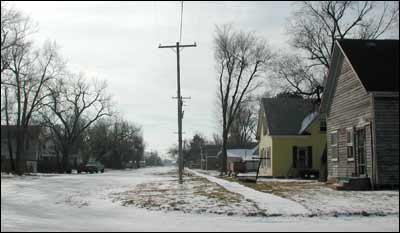
[January 14] Last Thursday, a 31-year-old woman was killed in Pawnee Rock. Treasa Carter died in the sunshine-yellow rental house at 515 Rock Street. She was stabbed by her husband, Duffie Roland Chapman, the sheriff's department says in the Great Bend Tribune. The house itself, which according to the Barton County tax records was owned in 2006 by William C. Dooley, is no palace. Its assessed value in 2005 was a mere $4,380, and last year that was lowered to $2,300 -- even a poor car is worth more than that. For as long as I've known the place it has been the home of folks walking the hard edge of life. Strained circumstances, it seems obvious, make it more likely that misfortune will have a place in the house. It's easy to say that people make their own luck, but think how things might have been different if more neighbors had helped a mother who some people might have known faced hard times. Through its collective choices, Pawnee Rock is making its own luck too. It's a human obligation to help others sidestep the tumbling boulder of misfortune. With kind words or something more substantial, we sometimes can postpone or prevent an act of evil. And for a family -- for a mother with two small children -- an uneventful life can be enough to wish for. The obituary for Treasa Carter suggests memorial donations to the Domestic Violence Prevention Fund, in care of Peterson Funeral Home of Newton. She will be buried Wednesday in Newton. The color of sunshine sometimes mocks life, but now it can be a beacon that reminds us that the community -- whichever town we live in -- must watch out for those least able to help themselves. A photo I like: No. 19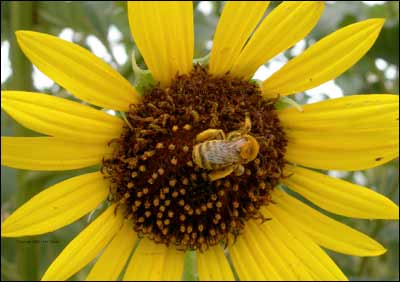
I made this photograph on a cloudy-bright August afternoon just outside the Pawnee Rock cemetery. A stand of sunflowers thrives in the ditch; it has for as long as I can remember. Back in the 1970s, a shot I made of a chilled bee on a sunflower one June morning appeared on the front page of the Larned Tiller & Toiler, and that image has been such a personal favorite that I've tried to improve on it every chance I get. Stormy weather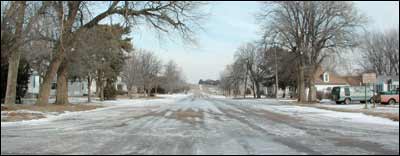
Centre Street looking north toward the Rock a few days after the January 2005 storm. [January 12] A couple of years ago my timing was good: I came in on the heels of a storm that left four or five inches of snow in Pawnee Rock. The flight from Denver to Wichita revealed lots of snow as far east as Hutchinson. As I drove my rented Toyota back toward Pawnee Rock, I stopped a couple of times and threw snowballs. It wasn't that I craved snow (you know where I live now), but it made me feel like a Kansas child again. This particular trip was to visit Dad in the Great Bend hospital, a few blocks from the Black Angus motel, where I was staying. Why not walk? One reason was that I could have broken my legs on the icy sidewalks, but I did it anyway. I spent a lot of time on that trip walking the streets of Pawnee Rock, photographing everything. The first day there was snow everywhere, reflecting hard light off the crust. The second and third days brought warmth and mud. By the time I left after a week, Pawnee Rock was greening up and looked ready for spring. I enjoy that about central Kansas. Inclement weather never seems to be the bad guest that stays for more than three days. Of course, the weather may trash the place before it leaves, but that's just the way life goes. Sleet and freezing rain are forecast for Pawnee Rock this week. We know that brings the risk of fallen power lines, but there's beauty in it too. I am always leery of going to Kansas in the winter. It's not that storms intimidate me anymore, but that I might be inconvenienced. I might have to spend an extra night in Wichita, or the roads might ice over. I wonder whether my concern is just an inborn need to find something to worry about. If I'm going to be stuck, after all, Kansas is a good place to be. I hear the whistle blow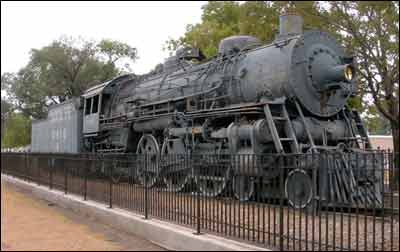
Santa Fe locomotive 3416, Great Bend. The locomotive was put into use in 1919 for passenger service west of Illinois and in the Gulf states. It was converted from coal to fuel oil in 1939, retired in 1953, and given to Great Bend in 1956. [January 11] Old Santa Fe 3416 has been a monument for 50 years. The paint has lost its luster, and a fence now holds the children back. But whenever I'm in Brit Spaugh Park in Great Bend, I come to this big-boned gray ghost and imagine. The steam locomotive is in our heritage; our town arose in 1872 when the tracks were laid. It brought our ancestors their coal and mail, sometimes even houses purchased by catalog, and it took our grain and passengers. In Texas and Hawaii, I rode on vacationers' trains pulled by steam locomotives. It was everything I imagined -- noisy, slow, and romantic in that certain old-timey way. Yet neither one of those locomotives was like this main-line machine, bursting with metal muscle. This was a locomotive that moved people, and now it moves my spirit. All I have to do is stand by the fence and listen for the whistle. Yesterday seems so close[January 10] It sure is fun to think about the good old days in Pawnee Rock, when life was simple and gas was cheap. Ah, yes, when all anybody had to worry about was the Great Depression, the Spanish flu, polio, dirt highways, the well going dry, tornadoes that came without warning -- all the things that made life worth living. I've babbled often to our sons about my own good old days and those I've heard about. "My mom . . . ," I've said. "When I was your age . . . We used to . . . The snow was so high. . . ." Nik does his best to play along. One evening he asked, "What are 'the good old days'?" "The good old days are when people forget the bad stuff and remember just the good stuff," I told him. He thought about it for couple of beats. "For me," he said brightly, "the good old days are yesterday and the day before." Cold-hearted days: On the wide-open prairie, the temperature in Pawnee Rock is likely to be the same as the temp in Great Bend as in Larned as in Pratt. But where our family lives now, the mountains make dozens of small temperature zones, and the thermometer readings vary wildly. For example, one of my co-workers who lives 45 minutes out of Anchorage had a 29-degree temperature change on the drive between his home and the newspaper office. It was -33 at home and a balmy -4 at work. Quarter update: On Nov. 19 and on Oct. 1, I complained about my bad luck in getting Kansas quarters in change. Total Kansas quarter count since October 1: One. Apparently I need to find a lucky penny, because this quarter thing just isn't working out. The ponds of Pawnee Rock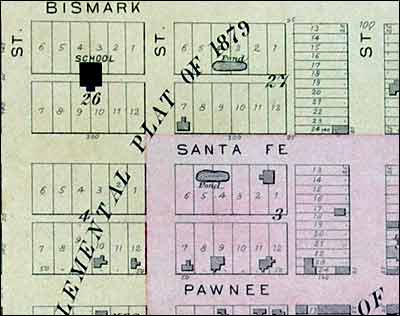
[January 9] As I looked over this page from the Barton County plat book of 1902, it struck me that there were once two ponds very close to where I grew up. Our home -- built about 50 years after this book was printed -- was on lots 10 and 11 of block 27, on the north side of Santa Fe Avenue. You can see the ponds across the street and across the alley. I never suspected, as I grew up, that Pawnee Rock had been such a watery paradise. In my existence, the northern pond would have been out the back door of the Gene Bowman house, and an overgrown nursery filled the place where the second pond was. Did boys like me try to go fishing in those ponds? Were the ponds just elegant mudholes mapped after a big rain? Or were the ponds an actual attempt by early Pawnee Rockers to collect and save water on our windswept prairie? Were mosquitoes and sanitation a problem? It's easy to imagine that horses or cattle were kept on those lots. I shouldn't be surprised that the ponds disappeared. I don't think anything else that's on this part of the plat still exists either, with the possible exception of the building at the southwest corner of the intersection of Pawnee Avenue and Centre Street. That horizontal building may be the longtime grocery store/American Legion hall. The school building is the town's original school, a long-gone structure built of sandstone. It was a different town back then. Wouldn't it be fun to go there for a day? The cold war[January 8] I've been reading a two-volume book about Army uniforms and weaponry of the 1870s, 1880s, and 1890s. Although it doesn't sound, at first blush, like the kind of book that would make for scintillating reading, I have found myself taken in by the author's command of the subject. The Army at the time had put the Civil War to rest and had returned to sweeping Indians off the plains -- including western Kansas -- and out of the mountains. In doing so, the soldiers wanted decent garments for the climate and terrain. What they had was a bureaucracy 2,000 miles away. What they needed was Cabella's. When I read about the buffalo coats and shoddy boots and mittens they wore to avoid freezing to death, I blushed a little at my own situation. To walk the dog last night when it was a mere -5, I put on insulated pants, a thin coat good to -45, my beloved stocking cap, a muffler, gloves, and felt-lined boots. The dog wore his simple black-and-white fur coat. I was warm and had a fairly good time tromping through the snow. Tonight the temperature is supposed to drop to around -25 for a couple of nights, and we'll see how reliable my coat is. A couple of decades ago, when I moved back to Kansas after a few years in Texas, I bought a green Thinsulate coat at Sears in Wichita after the first cold front came through. That very day, I pointed my Datsun hatchback west toward Ashland, and late in the day I found myself parked in the badlands surrounded by many square miles of brown pasture. Being a guy, I pulled out my Smith & Wesson Model 32 revolver (you never know when you'll need to kill a rattlesnake for supper) and fired a half-dozen .22 rounds at a prickly pear. Leon Unruh, the Plainsman. I wasn't there long. I was proud of my new wondercoat, but the Kansas wind was not impressed. It cut through my jeans, it bit my fingers, and it slid like an ice pick through that coat. And that was just November. I'm not saying this to overstate how chilly it was that evening, but having grown up in Kansas I can imagine what it was like standing sentry duty on the western and northern plains in January in the 1870s, perversely thinking that taking an arrow might not be a bad way to go if it meant my feet wouldn't be cold anymore. The Army folks have it a lot better these days. About 200 miles from where we live now is the Army's cold-climate proving area, where soldiers test gear at -60 degrees and live to tell about it. What 9th or 10th Cavalry soldier wouldn't have loved that kind of expertise behind his clothing? All in all, you and I have it pretty easy. Well, at least I do. Unlike the residents of snow-struck western Kansas, my power wasn't out for a week in January. Holidays: Tomorrow is Nixon's birthday. Martin Luther King Jr. Day is one week from today. Kansas Day is three weeks from today. Stock up on sunflower paper now, before the rush. Smile for George Brannan
[January 7] On the senior class pictures hanging in the old Pawnee Rock school building, you may have noticed the inscription: "Brannan's Studio . . . . . Great Bend." This was the mark of George Brannan. George's studio and store was on North Main Street in the 1100 or 1200 block. Its overhead sign was a blue circle with a curling arrow pointed toward the storefront. George owned one of central Kansas' first Honda Civics, back in the 1970s when buying a Japanese model was a sure sign of avant-garde eccentricity. He loved that little car, which was about the size of a double bed, and he drove it many miles as he carted his lights and camera to photograph school classes and weddings. A dozen fine portraits hung on the store walls: the prettiest girls, the handsomest football players, the most endearing brides and families. I wanted to take photos just like George, but I was not appropriately bossy and so found landscapes more to my temperament. His shop was a candy store for photographers. There were single-lens reflex cameras, as well as cable releases, tripods, flashes -- the separate kind that fit to the side of the camera or on top in the newfangled "hot shoe" -- and paper, chemicals, and 100-foot rolls of 35mm bulk film, which cost $22. These last items, necessary for my home darkroom, were how I spent the money I earned selling photos. George and his assistant, Ron Keil, were great friends to this young photographer. Their advice and encouragement came freely, but I had to earn their praise. I used George's formula for figuring what to charge for pictures I sold to classmates: "Once for Kodak, once for the camera, and once for me." When it came time, George took my senior portrait. I was disappointed that it never hung on the wall of his store -- sadly, there were boys more ruggedly handsome who came from families that could buy more prints -- but I was still proud that it was made by my mentor. A photo I like: No. 18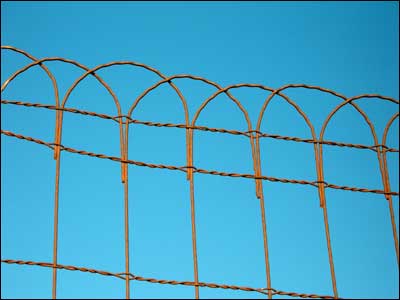
[January 6] We don't often see the simplicity and honesty in patterns unless we sit down and relax. This is the wire fence surrounding the Dundee Valley Cemetery just east of Dundee. Notice how the wires fit together, sliding through twisted loops and bending over for utility. The fence seems perfect for a cemetery that holds many of the area's early Mennonites. As anyone who drives to Great Bend along U.S. 56 knows, this cemetery's serenity has been spoiled by the relatively recent sandpit operation on three sides, but it remains an important part of our area's history. Photos and faces[January 5] My effort yesterday to fit history around my family took a happy turn when Brenda Jones, a cousin from Great Bend, sent a list of the members of the Peter A.R. and Sarah Unruh family. For a long time in my immediate-family lore, the folks in the photo below were identified from memory. But when I tried to find a photo of one of the girls, Rickie, it bothered me that she wasn't in the photo. That's when I asked Brenda for help. She sent a list of the 10 kids and their ages. Still, certain things didn't match up. (1) Why were three kids not in the photo? (2) The last two children on the list were born six years apart, but the youngest kids in the photo don't look six years apart. (3) The one kid my dad was sure of, (his dad) Otis in the lower left corner, would have been 12 years older than the infant if the baby were who we thought it was. Sometimes the simple answer is the best answer. The simple answer is that the photo doesn't include the people we thought it did. According to the list, the youngest and oldest kids were 20 years apart. You can see that, in the photo, they're not. The solution is blindingly obvious: Three kids we thought were in the photo are not, but not the three we thought. Instead, it's a photo of the first seven kids in the family. It was a classic case of trying to fit legend to the truth. But now we know the whole story. And the photo caption below has been corrected. Speaking of identification: Bravo to Jared Smith for sending in the IDs for the track team on yesterday's home page and now in the gallery. Jared wrote: "The photo today sure brought back some fond memories for me! It was taken in the spring of 1976 -- my last few months attending school in Pawnee Rock. The track team, coached by Gary Smith, was made up of 6th, 7th, and 8th grade students. I was amazed at how the names came back to me. Especially since a lot of the time I can't remember stuff from yesterday!" Who's who, and who you are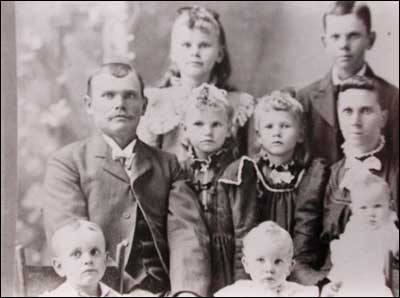
The Peter A.R. Unruh family with the first seven children. This photo was made right around 1902. Front: Otis, Clyde, Myrtle. Middle: Peter, Rickie, Carrie, Sarah. Back: Lillie, Harry. Not born yet: Vida, Arline, Donley. [January 4] The photo that appeared on the home page yesterday was a nice shot of a young couple, Rickie and Ed Deckert, in the early 1900s. Her name was catchy. You don't hear of many Rickies in Pawnee Rock, unless it's a guy. But I should have known this one. My mom says she was my great-aunt. 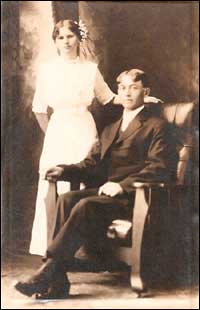 Rickie Unruh was the sister of my grandpa, Otis, and they were among the several kids of Mr. and Mrs. Peter A.R. Unruh. (Added to this entry later: It could have been a nickname; "Rickie" isn't in the Unruh names supplied by my dad for the photo and sent here by my sister, Cheryl. More details will emerge and this will be cleared up. [Later update: Cousin Brenda Jones clears up the mystery. Rickie was the second daughter (born around 1894) and she and two other kids simply weren't in the photo.]) Ed Deckert, as many of you know, was Leslie Deckert's brother. Rickie and Ed were the parents of Gene and Dwayne Deckert. I am glad to know all this. I am a little disappointed in myself for not remembering these details, because if I heard them once I heard them a dozen times. At what point do we realize that we should have paid attention to what the folks were saying? I guess I took for granted that the folks would always be there to tell me who was who and to explain the connections between families. As it happens, it was my mom who sent a note yesterday to tell me who Rickie was and who their sons are. And Larry Smith, who sent the photo in the first place, yesterday pointed out Ed's connection to Leslie. That's one of the nice things about being from Pawnee Rock. You know a little about my family, and I know a little about yours. We make a community, no matter where we live now, and we'll keep it alive if we keep talking. Kids, do yourself a favor. Sit down with your folks and draw up the biggest family tree you can. Put it with old family photos, and identify all the people in the photos. In 20 years, you'll treasure it more than you now think you will, for more reasons than you can imagine. George McGill, hometown celebrity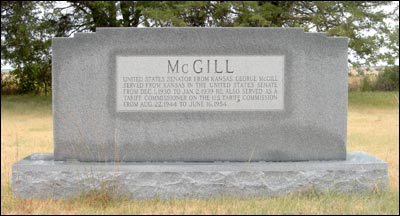 The McGill gravestone, Pawnee Rock Cemetery. [January 3] One of my favorite headstones to clip grass around when I worked at the Pawnee Rock Cemetery was George and Virginia McGill's. McGill . . . can't quite place the marker? It is an odd one, a little shy and yet audacious. When you drive down any street in the cemetery, you'll notice that the markers face the road -- you can see who's buried there. On the McGill stone in the northwest section, however, his and her names are on the side that faces away from the road. The casual visitor instead is offered the details of Mr. McGill's career in public life. 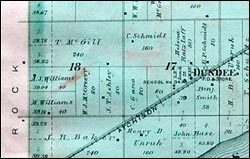 Mr. McGill was born in 1879 in Iowa and, after his parents moved to Kansas in 1884, grew up on a farm west of Dundee. (You can see the McGill property on this 1902 Liberty Township plat.) He went to Central Normal College in Great Bend and then studied law, bided his time as a lawyer in Hoisington and Wichita (Sedgwick County attorney for a while), and then in 1930, as the Great Depression settled in, was elected U.S. senator. McGill replaced Republican Henry Allen, who was appointed to the seat after the resignation of Republican Senator Charles Curtis, who left in 1929 after he was elected vice president under Herbert Hoover. Republican Arthur Capper was our other senator. Senator McGill was re-elected in 1932 and then defeated in 1938, and he cleaned out his desk in 1939. In fact, his last day in office was 68 years ago today. Senator McGill wasn't universally admired. A bunch of Kansans wrote a 1938 letter to Time magazine that included this little bit of loveliness about the man they called "Gloomy Gus":  "In the Senate: Balddomed, small chinned, doleful and dull of mien, Senator McGill has only one conspicuous mannerism -- a 'haha' which he inexplicably tacks on the end of his infrequent speeches. His voting record is Yes to every Roosevelt proposal: so faithful is he that, along with New Mexico's Hatch, he tried to launch a substitute Supreme Court bill after the President himself had given up." As McGill left office, the country was getting back on its feet and no longer needed a rubberstamping Democratic senator from Kansas. (The Sunflower State has had only three in 146 years; see a complete list of Republican, Democrat, and Populist senators.) Indeed, as Marty Keenan of Great Bend pointed out to me, McGill was Kansas' last Democratic senator. Just think: You could have been born, been educated, been drafted, been employed until retirement, and been the owner of a gold watch for three years -- and never have had a Democratic senator. After McGill was shown the door, he tried hard to get back in. He paid the bills with a seat on the U.S. Tariff Commission and as a hobby ran for the Senate again in 1942, 1948, and 1954. After that, he took up lawyering again in Wichita and died in 1963 at age 84. Then he was buried in the northwest section of the Pawnee Rock Cemetery, joining his wife, who had died a few months before. And that's where I met him, reading his epitaph as I clipped grass around his big chunk of granite and wondering what a guy who had been a senator was doing in our small-town cemetery. But he was just a guy from Dundee, someone who wanted to come home and rest. 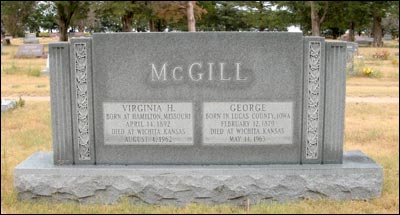 Dreams from the dark cellar[January 2] I read chapters of Goosebumps books to our 10-year-old almost every night. During the day he reads high-falutin' books, but he likes to relax with the 12-year-old characters in mild horror stories as he settles down for the night. 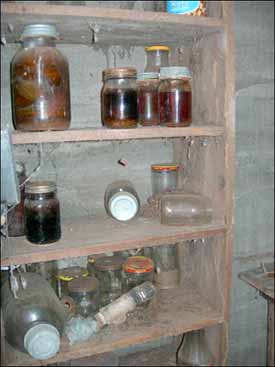 There are several predictable settings for these stories: moldy cellars, creaky stairs, animals that are larger than life. There are gooey liquids, hardware that the kids have never seen before, odd smells. Cans of Monster Blood. Can you imagine why I always think of the Unruh grandparents' storm cellar? When I visited the old farm northwest of Pawnee Rock this past summer, I double-dared myself to open the cellar door and descend those dank concrete steps. I still feared the spiders that I always knew were there, and on the shelves there were Grandma's home-canned vegetables. Sort of. They were more like mason jars of creepy Vegetable Blood, faint images of potatoes and cherries (perhaps) awash in liquid up to the jars' shoulders. That's what you get when you leave canned food to freeze and bake for 40 years under the Kansas prairie. In my childhood the farm was a place of endless entertainment for me, but there were bad moments too. I remember a few nights on sleepovers that I woke up with what I later learned were called night terrors. Each time, I promised to give my soul to Jesus if the fear would go away. Perhaps the dreams came at the farm because it was a place of such deep family emotions, especially after Grandpa died. Maybe it was from eating too much of Grandma's pickles and Pepsi, or perhaps I just had unresolved issues. I don't know whether Sam yet has the visceral ties to any place as I have to the old farm. Maybe he does, to a part of the woods behind the house, or to our crawlspace, or perhaps to a certain pile of boulders out at the state park. I just hope he collects a wide variety of emotional visits in his early years so that he can play with them in his mind when he's all grown up. If he's occasionally good and scared now, he'll be able to handle scary issues later. Sam is much better at handling the Goosebumps series than I was when I was about his age and was working my way through a book of Edgar Allen Poe stories. I had nightmares about the Tell-Tale Heart, but Sam doesn't seem to have bad dreams. He's a lucky fellow. The Goosebumps books are fun. The formula is usually the same: The hero kid is picked on by other kids, something weird happens but his parents won't listen to his problem, the kid faces a threat to his life, and he solves the problem. There's probably a moral in there, and the books always provide a humorous, justice-filled ending with a twist. I think it's the kind of story we'd all like to hear as we drift toward sleep, when we put our trust in the world. It's 2007. What are you going to do about it?[January 1] A long time ago, in a country much like these United States, college football bowl games used to mean something. One of those games, the 1969 Orange Bowl, involved the beloved Kansas Jayhawks. Kansas was this ( ) close to winning the game, but it had 12 men on the field during Penn State's failed two-point conversion attempt with less than two minutes to play. Given a second chance, Penn State scored on a similar attempt and won 15-14. (Details of a heartbreak.) I was one of (I assume) many Pawnee Rockers watching that evening game. It was my introduction to Kansas football, which by a series of fortunate events I got to cover as a photographer and reporter all through college. Goodbye to 2006; hello to 2007: I hope you all acted inappropriately for New Year's Eve. After all, what good is life if you can't enjoy it? If it were legal to shoot off fireworks where we live now, I'd tell you that we shot off many dollars' worth at the house of some friends up in the mountains, then had pizza and soft drinks. We went from there to the home of a beloved teacher, where we met a lot of people and had a bonfire in her front yard. But at 3 degrees, it's hard to say any bonfire is "bon" enough. Finally, we came home and, while the half-Philippine family across the street banged pots together outside at midnight, our boys threw onto the icy driveway those tiny gunpowder bags that explode on contact. All in all, it was a pretty good New Year's Eve. As I write this at 1:47 a.m., ice fog has moved into town and we'll have more snow by morning. Last year will be covered up and forgotten. May the sun shine bright: With the new year off to a rolling start, it's time to concentrate on basketball. Only a couple of months remain in the high school season before the state tournaments and the NCAA tournament. The sun's in the sky a few moments longer each day (9 hours 33 minutes today in Pawnee Rock, and 41 seconds more tomorrow). Kansas Day is 28 days away; it's 145 years of statehood come January 29. (If you're a Wally Hickel fan, Alaska will mark 48 years of statehood January 3. Hickel, a Claflin native, has been governor twice.) And for those who need lots of warning, Valentine's Day will return this year on February 14. The perfect gift? How about a sunset kiss atop Pawnee Rock? Howdy: And, finally, hello to Elizabeth. It has been too long. Copyright 2007 Leon Unruh |
Sell itAdvertise here to an audience that's already interested in Pawnee Rock: Or tell someone happy birthday. Advertise on PawneeRock.org. |
|
|
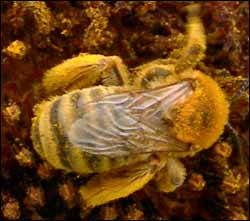 [January 13] There's a thrill in edging close to a bee and not getting stung. There's a thrill in freezing a skittish insect. When I do both, I'm a happy camper with a trophy.
[January 13] There's a thrill in edging close to a bee and not getting stung. There's a thrill in freezing a skittish insect. When I do both, I'm a happy camper with a trophy.